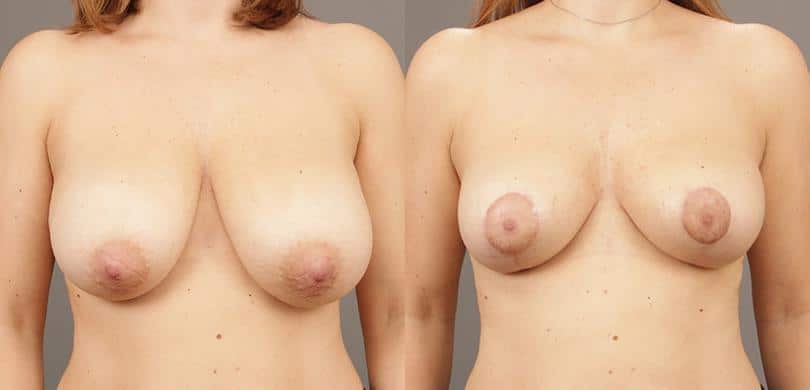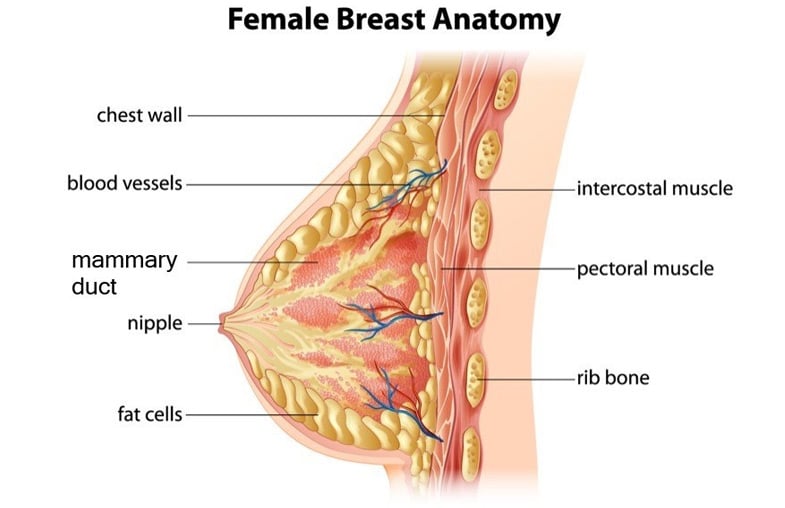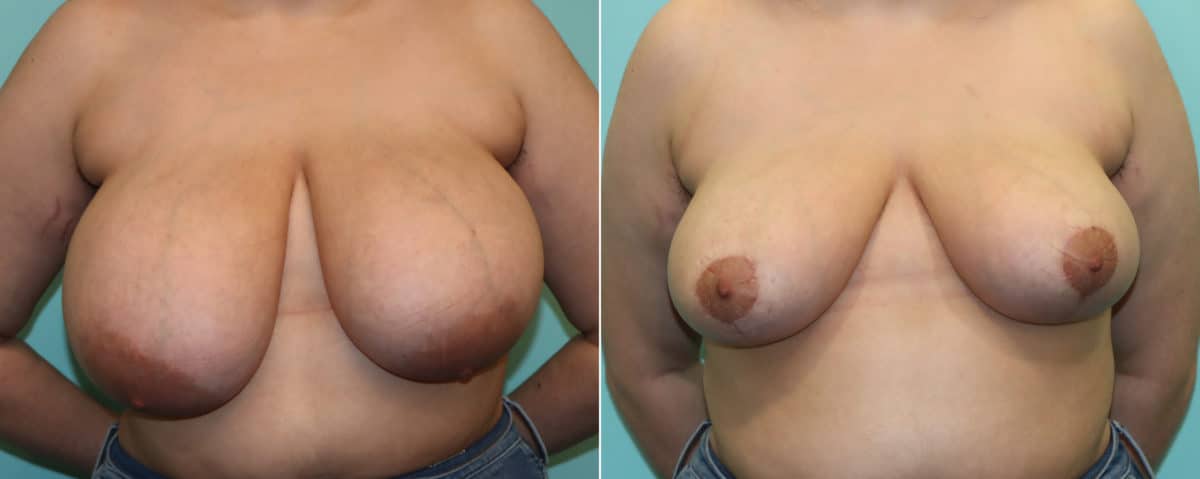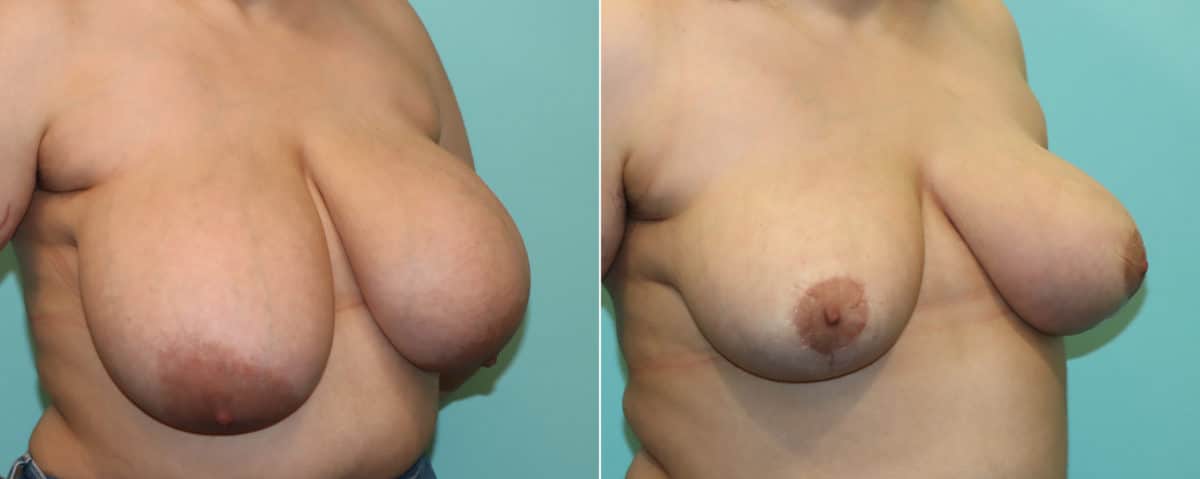Breast Reduction in Virginia, Washington D.C. and Maryland.
Embark on a journey of aesthetic excellence with The Naderi Center. Experience unparalleled artistry and precision for transformative beauty.
Experience Breast Reduction Benefits Today
Physical Comfort
Say goodbye to backaches and bra strap indentations. Enjoy a more active and comfortable life, unrestricted by your chest.
Enhanced Aesthetics
Achieve a balanced, harmonious physique that complements your overall appearance. Your new proportions will be your new confidence booster.
Lifestyle Freedom
From athletic pursuits to wardrobe choices, open up a world of possibilities that were once limited. Be unrestricted, be you.


Breast Reduction Overview
Huge breasts can be the beginning of physical problems such as back or shoulder pain. The bulkiness of sizable busts can trigger the ribbons of a bra to cut into the hide. Their burden also implies that physical actions and practices are uncomfortable. Generally, a bulky chest may be seen as alluring, but in fact, disproportionately immense bosoms can attract unintended interest, reducing a female’s self-worth.
Fortunately, the predicaments that come with a substantial chest can ordinarily be solved with a breast reduction treatment.
Breast Reduction: Causes of enlarged breast
- Excessive enlargement during puberty or during pregnancy and postpartum
- Weight gain
- Menopause
- Auto-immune diseases
- Medications

Breast Reduction Expected Results:
- Reduce the volume of a large chest
- Breast lift or improvement of sagging and drooping breast tissue
- Improve appearance, shape, position, and size of areolas which may have stretched and enlarged with time
- Restore a youthful, raised chest that will help a woman regain confidence in her body
Breast Reduction Summary

Mild to moderate
General Anesthesia
3-4 hours
Lollipop incision: circling around the areola, running downward from the nipple
2-3weeks
1 week
2-3 weeks
$10,500 – $12,500
Ideal Candidate for Reduction Mammaplasty
Women who experience discomfort due to the size and weight of their breasts may be suitable candidates for breast reduction surgery. The reduction mammoplasty procedure can be done at any age but the ideal candidate is an adult woman with mature breast tissue and in overall good health. It is also important that a patient has realistic expectations for the outcome of their surgery.
Women should have a keen understanding of the reduction mammaplasty process and the recovery requirements. Potential candidates for the reduction mammoplasty should be non-smokers. Women looking for assistance with smoking cessation should discuss this factor during the initial consultation appointment.
Good candidates for Reduction Mammaplasty are those who:
- Struggle with pendulous large breasts that make them uncomfortable with their appearance.
- Have asymmetric or uneven breasts, such as having one breast larger than the other.
- Experience skin irritation along and beneath the breast crease.
- Experience discomfort from heavy breasts, restricting physical activities.
- Have back, neck, and shoulder pain due to the heavy weight of the breasts
- Have indentations along the shoulders from tight bra straps.
- Are physically healthy.
- Have realistic expectations.
- Are in good health.
- Do not have any medical conditions that may delay and impair wound healing.
- Have a positive outlook and realistic aesthetic goals for what breast reduction surgery can accomplish.
- Are non-smokers.
Is there an ideal age to have a reduction mammaplasty?
Patients from teenagers (who have gone through their pubertal breast development stage) to adults can have breast reduction surgery. Having the procedure can help improve the quality of life and eliminate pain and discomfort from large breasts.
There is no age cutoff for breast reduction surgery. Many parents pursue reduction mammaplasty surgery for their teenagers because they feel that large breasts affect the quality of life of their children. When considering breast reduction for a younger patient, the following conditions are considered valid arguments to undergo breast reduction.
- Suffer from back pain.
- Suffer from neck pain.
- Suffer from inframammary rashes.
- Experience furrowing of shoulders from bra straps.
- Have poor posture.
- Have difficulty breathing or sleeping.
- Look to resize and/or reshape their breast
- Have difficulty finding clothing and proper support.
- Are athletic and participate in sports.
- Feel their breasts are not proportionate to their body.
Breast Reduction Surgical Technique
The reduction mammaplasty procedure will be performed at a nearby accredited surgical center or hospital on an outpatient basis. The reduction mammoplasty will take about three to four hours to complete, depending on the extent of correction. Any additional procedures, such as surgery through incisions or liposuction may affect this time. The surgeon will place the patient under general anesthesia.

Breast Reduction Techniques
Inferior Pedicle Technique (Inverted-T, anchor, and wise pattern)
The Inferior Pedicle Technique maintains the nerve and blood vessels to supply the nipple and breast. It results in elevated breasts that are more proportionate to the patient’s body. There’s a high likelihood of maintaining full lactation and breast function. This technique produces an “anchor” scar around the areola with a vertical scar down to a horizontal scar in the inframammary fold. There are occasions when a squared breast may result, although the technique is effective to reduce breast size.
Vertical Scar Technique (lollipop)
The “lollipop” technique provides short incision scars and well-projected breasts by means of a pedicle that provides nerve and blood supply to the breast. This technique removes small areas of skin and small volumes of internal tissues from all sides of the breast. It produces a “lollipop” scar around the areola with a vertical scar down towards the inframammary fold. This is the favored approach at The Naderi Center.
Horizontal Scar Technique
The horizontal scar technique is best for women whose breasts are too large for the vertical scar technique. You will have greater results with only a scar around the areola pedicle, designed to be tension free, and a horizontal scar along the inframammary fold along. There is the possibility of hypertrophy of incision scars, mostly on the inframammary fold, and boxy breasts. However, this technique reduces breast size and creates better healing of the areolar scar.
Free Nipple-Graft Technique (Donut)
The free nipple-graft technique allows for a larger amount of breast tissue to be removed to produce proportionate breasts. The incision is made around the areola to be grafted into a higher position, cutting off blood and vessel supply. This eliminates nipple sensitivity and the breast’s function capability for lactation. Candidates for this technique are those who are at high risk of ischemia, and necrosis, or are diabetic or smokers.
Liposuction-Only Technique
The liposuction-only technique consists of liposuction to reduce oversized breasts and remove a lighter volume of internal tissue, limiting the reduction of the breast volume. This technique is for patients who cannot be under the extended anesthesia period, and have low-density breasts composed primarily of fatty tissue, elastic skin, and ptosis. The technique produces a small scar in the lateral inframammary fold to provide access to the cannula, allowing for a shorter post-operative healing period.
Steps to Performing a Breast Reduction
Step 1
Inverted T Incision
Step 2
Removal of Excess Skin and Fatty Tissue
Step 3
Areola Reconstruction and Repositioning
Step 4
Closure of Incisions
Step 5
Post-Surgery Bra
Nipple Treatment During Breast Reduction Surgery
In order to achieve symmetry between the breast, the size of the areola may be reduced. Patients who undergo reduction mammaplasty are looking to resolve asymmetry between breasts. To accomplish this, during the surgery, the surgeon may need to reduce the size of the areola to fit the new breast size.
Testimonial
“I appreciated the attention to detail and the respect for my privacy and confidentiality I received.”
Cost of a Breast Reduction Procedure
There are a variety of factors that determine the overall cost of your reduction mammaplasty.
- Surgeons Fee: $10,500 – $12,500
- Anesthesia Fee: Depends on the length of the procedure
- Hospital and Surgical Facility Fees: Depends on the length of the procedure
- Post-Surgery Garments: Included with surgeon’s fee at The Naderi Center
- Pre-Surgical Medical Clearance and Lab Tests: Usually covered by medical insurance
- Medication Costs: Usually covered by medical insurance
- Follow-Up Visits: Included with surgeon’s fee at The Naderi Center
Breast Reduction And Coverage By Medical Insurance
The Schnur Scale helps to determine if it is medically necessary for a patient to undergo reduction mammaplasty surgery. The scale takes into consideration:
- Body Surface Area
- The average weight of breast tissue removed
Insurance companies countrywide use this scale in the process of pre-authorization for this procedure. Falling below the 22nd percentile deems the procedure to be cosmetic, and falling above considers the procedure to be medically necessary.
Preparation for a Breast Reduction
At The Naderi Center, we believe the success of your breast reduction surgery can be improved with proper preparation. We go above and beyond to make sure that our patients are medically, emotionally, and physically ready for surgery.
Please review our detailed instructions on reduction mammaplasty using the link below:
Scheduling a mammogram prior to your breast reduction
The patient may need a mammogram before and after surgery to identify any changes to breast tissue. The American College of Radiology and the Society of Breast Imaging recommend that women should start mammogram screening at the age of 40; earlier screenings are done if there is a family history of breast cancer.
Recovery after a Breast Reduction
Women should expect the recovery period from a reduction mammaplasty to take from one to two weeks. Most people are ready to return to work in five to seven days, sometimes even less. They will need to postpone exercise, heavy lifting, and strenuous activities for six to eight weeks to allow the breasts to properly heal.
There will be some mild to moderate discomfort following a reduction mammoplasty, but this will resolve over the first several days. Our breast and body plastic surgeon specialist will take care of the discomfort by prescribing needed medications during this time period. Patients will need to use a specialized surgical bra for several weeks.
A scar will result along the incision lines from the reduction mammaplasty procedure around the areola, down the mid-breast, and along the breast crease. Over time, the scar may fade somewhat, although it will remain visible. Most breast reduction patients are so pleased with their reduction mammoplasty results that they are not unhappy with the scarring, which can be concealed under clothing. Reduction mammaplasty is known to have one of the highest patient satisfaction ratings of all cosmetic procedures.
Your final breast size can take anywhere from six months to one year to fully form depending on the extent of your surgery and the natural healing process. Swelling of the breasts can last for months, making it important to follow our body plastic surgeon’s post-operative instructions to help your recovery time run smoothly and provide the best results as soon as possible.
Management of your scar after breast reduction
Proper self-care and The Naderi Center’s scar-taping technique can help reduce scarring. You will first see some redness and pink in the incision areas. In time, the scar will turn a darker color and flatten. An incision made in the inframammary fold may not be noticeable due to its hidden location.
For patients of darker skin tones, there is a risk of hyperpigmentation and keloids. Smoking and tanning can also cause irritation to incisions and worsen scars. In addition to following proper post-op care, using techniques such as scar massaging, silicone gels, laser treatments, and sunscreen usage can ensure minimal scarring.
Risks, Safety, and Potential Complications of Breast Reduction Surgery
Possible Complications after a Breast Reduction can Include:
- Risks of general anesthesia
- Excessive bleeding
- Skin changes or discoloration
- Poor incision healing
- Fluid accumulation or what is known as a seroma
- Nerve damage or numbness on the skin
- Change in nipple sensation
- Asymmetry or contour abnormalities
- Infection
- Potential impact on future breastfeeding
- Death of fatty tissue or fat necrosis
- Need for revision surgery
Breast Reduction Specialist
The first step for a reduction mammoplasty will initially call for a breast reduction consultation. Our surgeon will take this time to get to know the individual patient’s physical situation, as well as our desired results. The surgeon will fill out a full medical history form and perform a physical evaluation. Next, our specialist will explain the techniques for breast reduction and any questions will be answered at this time. If the reduction mammoplasty is determined to be the best option, our plastic body specialist will draw up a detailed surgical plan. At this time, the exact price of the breast reduction will be established, and a patient coordinator will review all of the payment options.

Known as a leader in cosmetic and plastic surgery procedures, The Naderi Center has been serving patients in the Virginia, Maryland, and Washington D.C. area for more than 10 years. The Naderi Center is known for being the source of physicians and surgeons that are ultra-specialized in their realm and scope of practice. Patients come to The Naderi Center when they want an expert on the procedure or condition they are trying to improve.
Contact one of The Naderi Center’s two offices for more information, or to schedule your breast reduction consultation. You can contact a patient coordinator at our Reston, Virginia office at 703-481-0002 and at our Chevy Chase, Maryland office at 301-222-2020.
Breast Reduction FAQs
Will I be able to breastfeed after surgery, and how soon?
There are five surgical techniques for breast reduction. Of those, our breast and body plastic surgeon specialist favors the vertical scar “lollipop” technique as this technique will not cut off nerve and blood supply to the breast, therefore allowing a woman to lactate. Our breast and body plastic surgeon specialist will determine if you are cleared to begin breastfeeding.
Will nipple sensation change? What are the chances of this happening
Under any type of surgical procedure performed on the breast, you may lose nipple sensation. Our surgeon’s preferred technique, the “lollipop,” does not cut off blood and vessel supply, therefore, the possibility of losing nipple sensation is low. With the free nipple or “donut” technique, the grafting of the nipple cuts off the supply and eliminates sensation.
What are the chances of having asymmetrical boobs after a reduction?
Achieving perfect breast symmetry and size is an unrealistic goal. The goal of breast reduction surgery is to accomplish good symmetry with breast and areola size and shape. Occasionally, some women experience squared breasts, or what is referred to as “boxy breasts”. This result depends on the surgical technique that your breast surgeon utilizes. At The Naderi Center, the surgical approach favored is the vertical scar technique, which will provide lifted symmetrical breasts.
Will my chances of having breast cancer in the future decrease if I have a breast reduction?
Breast cancer is acquired throughout a person’s lifetime. Theoretically, there is no correlation between reducing the chance of breast cancer through this breast surgery. Although, in the process of removing excess breast tissue, there is the possibility that abnormal cells that may later develop into breast cancer may also be removed.
Is breast reduction only for women that have large breasts?
Women who are looking to improve their self-image, want to resize or reshape their breasts, and are athletic also look into breast reduction surgery as it improves pain and discomfort brought on by asymmetric breasts that are not proportionate to their body, and excess breast tissue. Dramatic weight loss is where you see a more distinct difference in breast and body. The breast may not have lost all the volume, making the breasts look larger. When being examined and designated an ideal candidate, this is taken into consideration as well as where the patient falls in the Schnur Scale as a medically necessary procedure.
Should I lose weight before my breast reduction?
It is encouraged to reach your desired weight before breast reduction. Knowledge of the proper amount of breast tissue that will need to be removed is essential in determining if it is medically necessary, or strictly for cosmetic purposes.
What breast reduction office is near me?
If you live in the states of Virginia or Maryland, The Naderi Center for Plastic Surgery and Dermatology offers breast reduction among its services. For a full list of services, please visit our Locations page.
Do You Accept Insurance?
Yes, we accept medical insurance. Please note that our surgeons are typically out-of-network providers. Verify your benefits—including Medicaid, TRICARE, or other plans—with your insurance company before scheduling your consultation.



